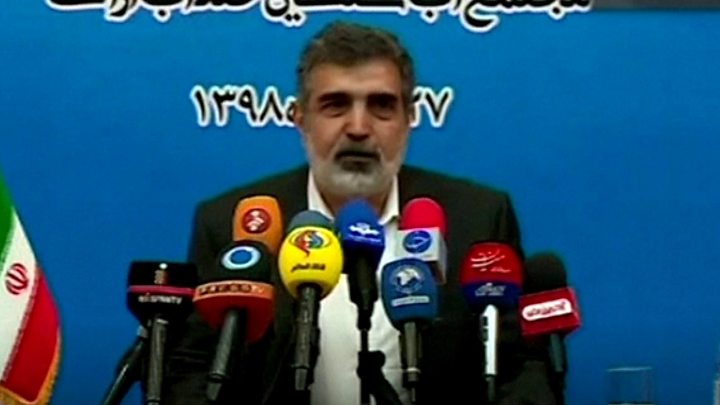Gulf of Oman: US sends more troops amid tanker tension with Iran
 Image copyright US Department of Defense
Image copyright US Department of Defense The US military will send an additional 1,000 troops to the Middle East as tensions build with Iran.
Acting Defence Secretary Patrick Shanahan said the deployment was in response to what he described as “hostile behaviour” by Iranian forces.
The US Navy also shared new images it says link Iran to recent oil tanker attacks in the Gulf of Oman.
Iran announced on Monday it would no longer comply with part of the 2015 deal on curbing its nuclear ambitions.
It said it would breach a limit agreed with international powers on its enriched uranium stockpiles by 27 June.
What do we know about the extra troops?
The US troop deployment to the Middle East was announced by Mr Shanahan late on Monday.
In his statement, he said the “United States does not seek conflict with Iran” but the action was taken to “ensure the safety and welfare of our military personnel working throughout the region to protect our national interests”.
“The recent Iranian attacks validate the reliable, credible intelligence we have received on hostile behaviour by Iranian forces and their proxy groups that threaten United States personnel and interests across the region.”
He said the military would continue to monitor the situation and make adjustments to troop levels accordingly.
No details were given about where exactly the extra US forces would be posted.

Media playback is unsupported on your device
Monday’s troop increase announcement comes on top of 1,500 extra announced by President Donald Trump last month.
Secretary of State Mike Pompeo said on Sunday that the US did not want war with Iran, but was nevertheless “considering a full range of options”.
He is due to meet the US military commander responsible for the Middle East at Central Command in Florida on Tuesday.
What do the latest images show?
Shortly before the announcement, the Pentagon released new images including some purporting to show the remnants of an unexploded mine on a Japanese-owned oil tanker.
The photos appear to show it being removed by members of the Iranian Revolutionary Guard Corps. The Pentagon has already released grainy video said to show the same episode.
Also seen in the latest images is apparent damage – a hole – above the waterline on the hull of the Kokuka Courageous vessel.
Another image claims to show the Iranian Revolutionary Guard Corps vessel shortly after it was involved in removing the limpet mine.
A Norwegian-owned tanker, the Front Altair, also reported being hit by blasts on Thursday.
The US has implicated Iran in the latest attacks and four others outside the Strait of Hormuz in May.
Iran has denied any involvement and called the latest US accusations “unfounded”.
Why are there new tensions?
In 2015, Iran agreed to a landmark deal with world powers to curb its nuclear development.
It agreed to limit the enrichment of uranium, which is used to make reactor fuel but also nuclear weapons, and other measures in return for relief from sanctions.
Mr Trump abandoned the nuclear accord last year and started to re-impose sanctions.
The move has crippled Iran’s economy, which relies on oil, and Iran has responded by scaling back its nuclear commitments.

Media playback is unsupported on your device
On Monday, a spokesman for its Atomic Energy Organisation said it was on course to exceed agreed limits on its enriched uranium stockpiles within 10 days.
But, Iran said there was “still time” for European countries to act by protecting Iran from reinstated US sanctions.
The US responded by accusing Iran of “nuclear extortion”.
The UK, France and Germany have warned Iran not to violate the 2015 deal.




